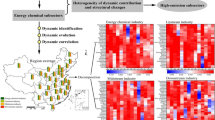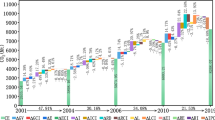Abstract
Thermal power, steel, cement, and coal chemical industries account 62.6% energy consumption and 84.6% carbon emissions of China simultaneously in 2015. This research use C3IAM-Tice model to analyze the impact of advanced technologies ratio increasing quantitatively. The model can explore the balance of emission reduction and economy efficiency of energy use, finally got the technology structure optimization for these four industries. The paper uses the historical energy consumption and CO2 emission, combing with the low-carbon developing goal objection, to create the database for these four energy- and carbon-intensive industries. As the result, the scenario-4, which is the most advanced technology-oriented strategy, shows 282 Mt CO2 emission reductions for the 2020 Goal. In this scenario, 26.19%, 47.43%, 65.39%, and 28.98% of the CO2 emissions per unit of added value in thermal power industry, steel industry, cement industry, and coal chemical industry could be reduced comparing with data in 2005. Although the advanced technology-oriented strategy shows the positive impact, we need to consider the cost of elimination of existed technology. On the other hand, the paper notices the future technology, with new energy alternative, low-carbon economy development, and industry restructure together, which are important factors for the low-carbon development of China.




Similar content being viewed by others
References
Cai Y, Newth D, Finnigan J, Gunasekera D (2015) A hybrid energy-economy model for global integrated assessment of climate change, carbon mitigation and energy transformation. Appl Energy 148(3):381–395
China National Bureau of Statitics (2005–2015) China energy statistical yearbook. China Statistics Press
China National Bureau of Statitics (2013) China statistical yearbook. China Statistics Press, Beijing
CNEB (2015) Energy development in “13-th plan”. Chin Natl Energy Bur 19(1):1–47
Deja J, Uliasz-Bochenczyk A, Mokrzycki E (2010) CO2 emissions from Polish cement industry. Int J Greenh Gas Control 4(4):583–588
Dietzenbacher E, Lenzen M, Los B, Guan D, Lahr ML, Sancho F, Suh S, Yang C (2013) Input–output analysis: the next 25 years. Econ Syst Res 25(4):369–389
El-Khattam W, Hegazy YG, Salama MMA (2005) An integrated distributed generation optimization model for distribution system planning. IEEE Trans Power Syst 20(2):1158–1165
Energy Information Administration (1994) The national energy modeling system: an overview
Gabriel S, Kydes A (1994) The national energy modeling system: a large-scale equilibrium model at the U.S. Department of Energy
Hasanbeigi A, Arens M, Cardenas JCR, Price L, Triolo R (2016) Comparison of carbon dioxide emissions intensity of steel production in China, Germany, Mexico, and the United States. Resour Conserv Recycl 113:127–139
Lansey KE, Mays LW (1989) Optimization model for water distribution system design. J Hydraul Eng 115(10):1401–1418
Lin B, Wang X (2015) Carbon emissions from energy intensive industry in China: evidence from the iron & steel industry. Renew Sustain Energy Rev 47:746–754
Liu L, Zong H, Zhao E, Chen C, Wang J (2014) Can China realize its carbon emission reduction goal in 2020: from the perspective of thermal power development. Appl Energy 124:199–212
Mikulčić H, Vujanović M, Fidaros DK, Priesching P, Minić I, Tatschl R, Duić N, Stefanović G (2012) The application of CFD modelling to support the reduction of CO2 emissions in cement industry. Energy 45(1):464–473
Miller RE, Blair PD (2009) Input-output analysis—foundations and extensions. Cambridge University Press, Cambridge
Nakata T (2004) Energy-economic models and the environment. Prog Energy Combust Sci 30(4):417–475
Quirion P (2015) Global sensitivity analysis of an energy-economy model of the residential building sector. Environ Model Softw 70(1):45–54
Rahman M, Pudasainee D, Gupta R (2017) Review on chemical upgrading of coal: production processes, potential applications and recent developments. Fuel Process Technol 158:35–56
Schank J (1978) Multiobjective analysis in a national energy system model
Shen L, Gao T, Zhao J, Wang L, Wang L, Liu L, Chen F, Xue J (2014) Factory-level measurements on CO2 emission factors of cement production in China. Renew Sustain Energy Rev 34:337–349
Sun WQ, Cai JJ, Mao HJ, Guan DJ (2011) Change in carbon dioxide emissions from energy use in China’s CO2 iron and steel industry. J Iron Steel Res Int 18(6):31–36
Timmer MP, Dietzenbacher E, Los B, Stehrer R, de Vries GJ (2015) An illustrated user guide to the world input-output database: the case of global automotive production. Rev Int Econ 23(3):575–605
Tukker A, Dietzenbacher E (2013) Global multiregional input-output frameworks: an introduction and outlook. Econ Syst Res 25(1):1–19
Wang K, Wang C, Lu X, Chen J (2007) Scenario analysis on CO2 emissions reduction potential in China’s iron and steel industry. Energy Policy 35(4):2320–2335
Wei W, Ren X, Cai Z, Hou Q, Liu Y, Li Q (2015) Research on China’ s greenhouse gas emission——progress on emission inventory from the CAS strategic priority research program. Bull Chin Acad Sci 6:839–847
Wiedmann T (2009) A review of recent multi-region input–output models used for consumption-based emission and resource accounting. Ecol Econ 69(2):211–222
World Steel Association (2013) Steel statistical yearbook
Xie K, Li W, Zhao W (2010) Coal chemical industry and its sustainable development in China. Energy 35(11):4349–4355
Xu D, Cui Y, Li H, Yang K, Xu W, Chen Y (2015) On the future of Chinese cement industry. Cem Concr Res 78:2–13
Xu W, Wan B, Zhu T, Shao M (2016) CO2 emissions from China’s iron and steel industry. J Clean Prod 139:1504–1511
Yahoo M, Othman J (2015) Carbon and energy taxation for CO2 mitigation: a CGE model of the Malaysia. Environ Dev Sustain 19(1):239–262
Yan D, Lei Y, Li L, Song W (2017) Carbon emission efficiency and spatial clustering analyses in China’s thermal power industry: evidence from the provincial level. J Clean Prod 156:518–527
Yang H, Lu L, Zhou W (2007) A novel optimization sizing model for hybrid solar-wind power generation system. Sol Energy 81(1):76–84
YuanYuan Z, Yonggang W, Yajun T (2016) Comparative studies on carbon dioxide emissions of typical modern coal chemical process. Chem Ind Eng Process 35(12):4060–4064
Zhou W, Zhu B, Li Q, Ma T, Hu S, Griffy-Brown C (2010) CO2 emissions and mitigation potential in China’s ammonia industry. Energy Policy 38(7):3701–3709
Acknowledgements
This research is supported by (1) National Key R&D Program (Nos. 2016YFA0602603, 2016YFA0602602); (2) National Natural Science Foundation of China (No.51778601); (3) Shanghai Science and Technology Committee key R & D projects (No.15DZ1170600); (4) Chinese Academy of Sciences Youth Innovation Promotion Association Funding.
Author information
Authors and Affiliations
Corresponding authors
Additional information
C3IAM-Tice: China Climate Change Integrated Assessment Model for technology impact of industry carbon emission.
Electronic supplementary material
Below is the link to the electronic supplementary material.
Rights and permissions
About this article
Cite this article
Wang, M., Zhang, L., Su, X. et al. Assessing the technology impact for industry carbon density reduction in China based on C3IAM-Tice. Nat Hazards 99, 1455–1468 (2019). https://doi.org/10.1007/s11069-018-3484-8
Received:
Accepted:
Published:
Issue Date:
DOI: https://doi.org/10.1007/s11069-018-3484-8




